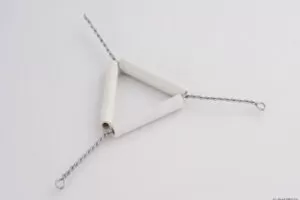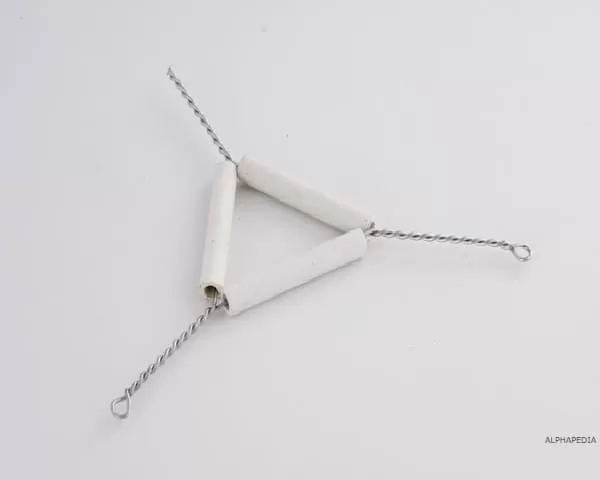What is the Clay Triangle ? Definition
The porcelain triangle is a laboratory material used to contain crucibles when heated. It consists of 3 sections of galvanized wire that form a triangle. Each edge of that triangle has a porcelain tube. The ends of the wires twist and project from each corner of the triangle.
A porcelain triangle is laboratory equipment used in the process of heating substances. It is used in conjunction with other laboratory equipment to create a stable frame in which to place a substance, usually a solid chemical, while heating to a high temperature.
A porcelain triangle is a wire and ceramic triangle used to hold a crucible while heating it over a Bunsen burner. A crucible is a ceramic vessel with a lid that is used to heat solid chemicals to high temperatures to dry them out completely or to induce a reaction without solution.
A clay triangle consists of three sections of galvanized wire arranged in the shape of a triangle. The ends of the wires are twisted together, forming three straight cable stems that project out from each corner of the triangle. Each side of the wire triangle is covered with a ceramic sleeve, which is capable of withstanding very high temperatures over the direct flame of a Bunsen burner.
Function of the Laboratory Clay Triangle
The porcelain triangle is used in the heating assembly of a substance. Its function is specifically to hold a porcelain crucible inside and, in turn, the triangle is held in a metal ring that is attached to a universal holder.
What is the Laboratory Clay Triangle for?
Also known as a clay triangle, it serves as a support structure for the elements that are heated in a Bunsen burner or other open flame heat source in a laboratory environment.
The appliance is shaped like an equilateral triangle with three 60-degree angles. A tubular clay triangle is constructed from wires with ceramic or catlinite tubes, allowing it to support heat-resistant crucible vessels while providing direct heat.
The alternative is a wire gauze, which is more suitable for working with beakers and other glass containers that need indirect exposure because they can be damaged by direct heat. Both items are widely used in laboratories conducting chemical experiments.
Using the Porcelain Lab Triangle
The porcelain triangle is formed by three twisting iron wires, covered with three unglazed porcelain tubes. It is formed as a triangle, hence the name porcelain triangle. In the laboratory, it is usually used together with an iron tripod to heat the crucible.
The crucible is commonly made of porcelain, the iron tripod is made of iron. Because of the different coefficients of expansion of iron and porcelain, heating the crucible in direct contact with the tripod iron can cause cracks in the porcelain crucible.
The porcelain triangle is not easy to break due to its relatively simpler shape than the crucible, its thickness and its heat-resistant ceramic tubes. In addition, its iron wires are strong enough to support a heavy crucible. Therefore, when the crucible or object is heated with a Bunsen burner (or alcohol burner) in the laboratory, a layer of tubing is usually placed over the iron tripod to protect the ceramic crucible from cracking.
How to use
- To use a porcelain triangle, attach an iron ring to a ring holder. This creates a frame to hold your appliance over a Bunsen burner.
- Place the porcelain triangle on the iron ring and place the Bunsen burner under it.
- Place the crucible on the clay triangle.
- Now you are ready to heat the crucible.
Price in Euros and Dollars of the Clay Triangle
- Porcelain triangle – 50 mm (Pk10)
- Price: £ 4.92
- Refractory Porcelain Triangle 50 mm
- Price: 2,00
Clay Triangle Sizes
Porcelain triangles consist of twisted metal wires in the shape of a triangle with sections of ceramic tubing and are used to securely hold a small crucible on a tripod. There are many sizes available and it is important to use the correct size for the type of crucible you are heating; triangles that are too small or damaged can allow the crucible to slip.
- Clay pipe triangles allow the crucible to heat directly and are less cumbersome than crucible clamps.
- According to the size of the crucible, three types can be chosen: 55 mm, 65 mm and 75 mm (depending on the length of the porcelain triangle).
- We also find them of 75mm, 60mm, 50mm and 30mm
Clay Triangle Measurements
Their dimensions vary widely, although the most common lengths are between 1.5 and 2.5 inches long.
Clay Triangle Capacity
It comes in a capacity of approximately 500 ml, 700 ml and 1000 ml.
Clay Triangle for Chemistry Laboratory
Porcelain triangles are ideal for heating things up in science laboratory chemistry experiments. They are designed to support a crucible, allowing it to be heated directly with a Bunsen burner or other heat source.
Image and Photo of the Porcelain Triangle



